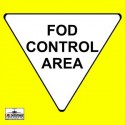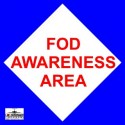Compliments of “The Combat Edge” Magazine
By SMSgt Jeffery B. England, Seymour Johnson AFB, N.C.
Most of us are familiar with the term Foreign Object Debris/Damage or FOD. Foreign objects and debris (i.e., rocks, nails, screws, fasteners, tools, rivets, and wire) can find their way into the strangest places and do considerable damage. Those of us who work on or near the flightline are thoroughly aware of FOD and its associated hazards, but a reminder every now and then never hurts. Damage to aircraft caused by FOD ingestion can be very expensive. We must do all we can to prevent and control FOD.
FOD can have devastating effects on a jet engine because the intakes operate like giant vacuum cleaners, sucking up anything and everything in their path. Some aircraft engine intakes are very close to the ground. This includes the French KC-135 tankers, F/A-18 Hornets, and Mirage 2000Ds operating at Manas International Airport in Kyrgyzstan. The F-16 Fighting Falcon is also extremely susceptible to FOD because of its powerful engine, large intake, and proximity to the ground. Bits of rock, sand, grass, metal, and even ice and snow ingested into a jet engine can cause significant damage to the compressor blades and other internal parts. This translates into a lot of money to repair or replace a FOD-damaged engine.
FOD is a real threat wherever planes take to the air, but it is especially prevalent at our deployed locations. Runway and taxiway construction in foreign locations is not always up to the same standard as it is in the United States. Maintenance of these surfaces may not receive regular attention from civil engineering like they normally do at military installations stateside. Consequently, FOD can be found on the parking aprons, taxiways, and runways of almost every airport and airbase in the world.
The prevention and control of FOD is key to the preservation of our aircraft and the safety of those personnel working in, on, and around aircraft. This is even more true at a bare base or joint-use civilian airfield typically used for contingency operations. While deployed, we need to adopt the same standard FOD operating procedures that we use at home.
This starts with awareness of its presence on the parking ramp, taxiways, runways, and even the roads that lead into and out of these areas. Good housekeeping on the parking ramp will go a long way in preventing hardware, stones, rocks, rubbish, and clothing from finding its way into a jet engine. This is the responsibility of every aircrew member, mechanic, technician, and driver who works on the flightline.
If you see FOD, pick it up and dispose of it properly. That means place it in a sealable container and dispose of it far away from the flightline so it can’t find its way back lodged in the tires of someone’s vehicle. Make FOD containers (cans, buckets, pouches, or bags) available in every flightline vehicle and in every flightline work area. Attach FOD containers to toolboxes and ground equipment. This is especially important at deployed locations because of the greater amounts of FOD. Don’t forget to empty the FOD containers daily.
When you drive a vehicle, inspect your tires before driving onto the flightline or taxiway. If you don’t conduct thorough vehicle FOD checks, your tires can pick up rocks and deposit them in the flightline area. Make every attempt to stay on paved surfaces. Avoid driving on the dirt or grass whenever possible. If you must depart the pavement to avoid a greater risk (i.e., an airplane taxiing straight at you), check your tires for FOD once you return to the pavement and dispose of it properly and immediately. These simple FOD-prevention measures can avoid millions of dollars and hundreds of man-hours we currently spend to repair or replace the damage.
The key to FOD prevention and control is constant vigilance and immediate action to remove the hazards from the area. The mission — especially at deployed locations — depends on assets being fully mission capable. That can only happen when everyone does their part to prevent FOD.
Watch out for FOD!
August 14, 2008 by



